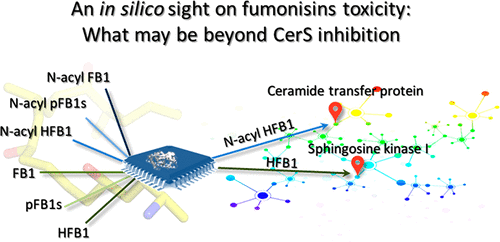当前位置:
X-MOL 学术
›
Chem. Res. Toxicol.
›
论文详情
Our official English website, www.x-mol.net, welcomes your
feedback! (Note: you will need to create a separate account there.)
Mechanisms of Fumonisin B1 Toxicity: A Computational Perspective beyond the Ceramide Synthases Inhibition
Chemical Research in Toxicology ( IF 3.7 ) Pub Date : 2018-10-22 00:00:00 , DOI: 10.1021/acs.chemrestox.8b00188 Luca Dellafiora 1 , Gianni Galaverna 1 , Chiara Dall’Asta 1
Chemical Research in Toxicology ( IF 3.7 ) Pub Date : 2018-10-22 00:00:00 , DOI: 10.1021/acs.chemrestox.8b00188 Luca Dellafiora 1 , Gianni Galaverna 1 , Chiara Dall’Asta 1
Affiliation

|
Fumonisins are mycotoxins produced by Fusarium fujikuroi species complex that may contaminate food and feed threatening human and animal health. Among the fumonisins group, fumonisin B1 is the most widespread and best characterized in terms of toxicity, while additional toxicological data on its congeners, such as N-acylated and hydrolyzed forms, need to be collected to support the group-based risk assessment. The inhibition of ceramide synthase has been identified as the key molecular mechanism of fumonisins toxicity resulting in modifications of sphingolipids rheostat. However, the existence of ancillary mechanisms and biological targets are likely to occur given the growing number of evidence reporting the multitarget mechanisms of mycotoxins toxicity. Therefore, in the framework of the early warning analysis of multitarget toxicity of fumonisins group, the present study aimed at searching potential targets for future hazard characterization studies of fumonisin B1 and its hydrolyzed and N-acetylated forms. In particular, on the basis of structural analogies with known inhibitors, the molecular interaction between N-acylated and hydrolyzed forms of fumonisin B1 and either ceramide transfer protein or sphingosine kinase I was assessed with a molecular modeling study. Our results pointed out that the molecular features of N-acylated hydrolyzed fumonisin B1 and hydrolyzed fumonisin B1 may allow the interaction with the ceramide transfer protein and with the sphingosine kinase I enzyme, respectively. Overall, our results identified such proteins as relevant targets that might take part in fumonisins group toxicity, adding plausible mechanistic insights to better understand fumonisins toxicity. Moreover, possible divergences in the mechanisms of action of fumonisin B1 and its modified forms were identified pointing out the need to assess their relevance with high priority to enhance the understanding of group toxicity.
中文翻译:

伏马毒素B1毒性的机制:神经酰胺合成酶抑制作用以外的计算角度。
伏马毒素是霉菌镰刀菌产生的霉菌毒素可能污染食品和饲料的物种复合物,威胁到人类和动物的健康。在伏马菌素组中,伏马菌素B1在毒性方面是分布最广,特征最好的,同时还需要收集其同类物的其他毒理学数据,例如N-酰化和水解形式,以支持基于组的风险评估。神经酰胺合酶的抑制已被确定为伏马菌毒素毒性的主要分子机制,其导致鞘脂变阻器的修饰。但是,鉴于越来越多的证据表明霉菌毒素毒性的多靶点机制,辅助机制和生物学靶点的存在可能会发生。因此,在伏马菌素组多靶点毒性的早期预警分析框架内,本研究旨在寻找伏马菌素B1及其水解和N-乙酰化形式的未来危害特征研究的潜在目标。特别地,基于与已知抑制剂的结构相似性,通过分子建模研究评估了伏马菌素B1的N-酰化和水解形式的伏马菌素B1与神经酰胺转移蛋白或鞘氨醇激酶I之间的分子相互作用。我们的结果指出,N-酰化的水解伏马毒素B1和水解伏马毒素B1的分子特征可能分别与神经酰胺转移蛋白和鞘氨醇激酶I酶相互作用。总体而言,我们的结果确定了此类蛋白质为可能参与伏马毒素的组毒性的相关靶标,从而增加了合理的机理见解,以更好地了解伏马毒素的毒性。
更新日期:2018-10-22
中文翻译:

伏马毒素B1毒性的机制:神经酰胺合成酶抑制作用以外的计算角度。
伏马毒素是霉菌镰刀菌产生的霉菌毒素可能污染食品和饲料的物种复合物,威胁到人类和动物的健康。在伏马菌素组中,伏马菌素B1在毒性方面是分布最广,特征最好的,同时还需要收集其同类物的其他毒理学数据,例如N-酰化和水解形式,以支持基于组的风险评估。神经酰胺合酶的抑制已被确定为伏马菌毒素毒性的主要分子机制,其导致鞘脂变阻器的修饰。但是,鉴于越来越多的证据表明霉菌毒素毒性的多靶点机制,辅助机制和生物学靶点的存在可能会发生。因此,在伏马菌素组多靶点毒性的早期预警分析框架内,本研究旨在寻找伏马菌素B1及其水解和N-乙酰化形式的未来危害特征研究的潜在目标。特别地,基于与已知抑制剂的结构相似性,通过分子建模研究评估了伏马菌素B1的N-酰化和水解形式的伏马菌素B1与神经酰胺转移蛋白或鞘氨醇激酶I之间的分子相互作用。我们的结果指出,N-酰化的水解伏马毒素B1和水解伏马毒素B1的分子特征可能分别与神经酰胺转移蛋白和鞘氨醇激酶I酶相互作用。总体而言,我们的结果确定了此类蛋白质为可能参与伏马毒素的组毒性的相关靶标,从而增加了合理的机理见解,以更好地了解伏马毒素的毒性。

































 京公网安备 11010802027423号
京公网安备 11010802027423号